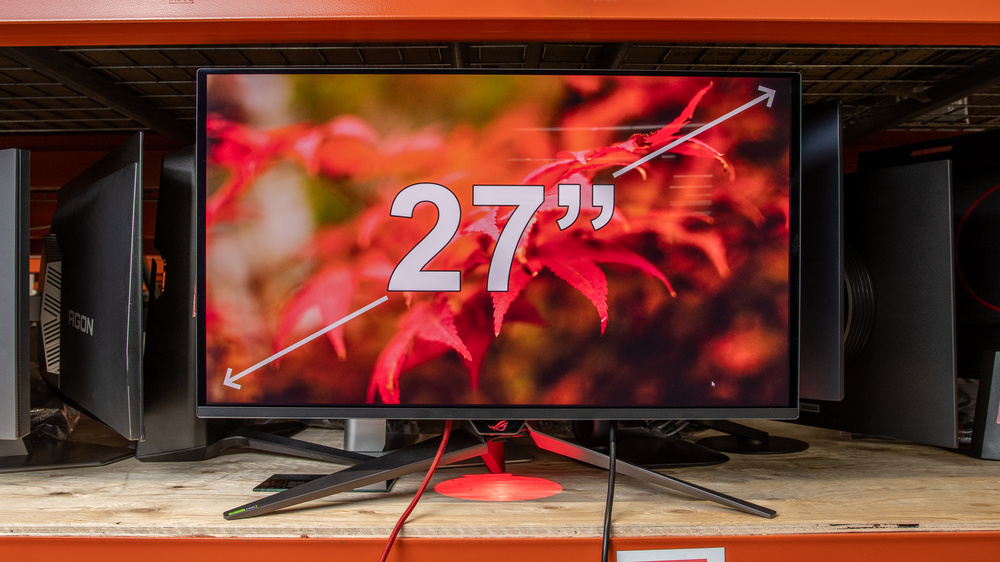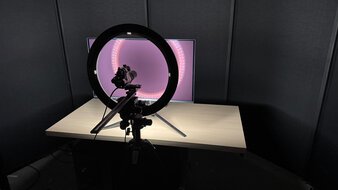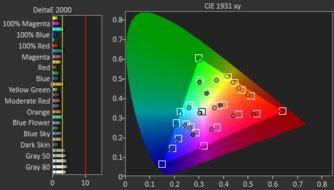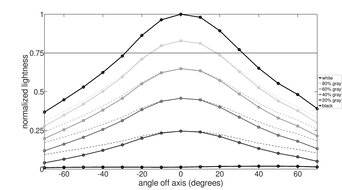One of the most common monitor sizes is 27 inches, even if there are bigger displays available. One advantage of getting a 27-inch monitor is that it isn't so big that it's overwhelming on your desk, and it still offers enough screen real estate to place two windows side by side. There's a wide range of 27-inch monitors available with various resolutions, refresh rates, panel types, and features. These monitors are also available at different price points, so you can find something no matter your budget.
Most are good enough for everyday use, and many even include gaming features like high refresh rates and HDMI and DisplayPort 2.1 bandwidth. That said, if you don't need gaming features and prefer something for productivity, many have extra features like USB hubs and ergonomic stands. Although there's no perfect solution for everyone, you should consider what type of monitor you need for your use.
We've bought and tested over 375 monitors, and below are our recommendations for the best 27-inch monitors you can buy. Also, check out our recommendations for the best 27-inch gaming monitors, the best work monitors, and, if you want other sizes, the best monitor sizes for gaming. You can also learn more about 24- vs 27-inch monitors and 27- vs 32-inch monitors.
Quick Look


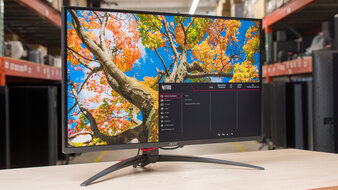



We buy and test more than 30 monitors each year, with units that we buy completely on our own, without any cherry-picked units or samples. We put a lot into each unbiased, straight-to-the-point review, and there's a whole process from purchasing to publishing, involving multiple teams and people. We do more than just use the monitor for a week; we use specialized and custom tools to measure various aspects with objective data-based results. We also consider multiple factors before making any recommendations, including the monitor's cost, its performance against the competition, and whether or not it's easy to find.
-
Best 27-Inch Monitor
 Office8.3Editing9.3PC Gaming9.1Console Gaming9.4Brightness7.2Response Time9.9HDR Picture9.4SDR Picture10Color Accuracy9.2Size27"Pixel TypeQD-OLEDMax Refresh Rate240 HzSee all our test resultsNative Resolution3840 x 2160
Office8.3Editing9.3PC Gaming9.1Console Gaming9.4Brightness7.2Response Time9.9HDR Picture9.4SDR Picture10Color Accuracy9.2Size27"Pixel TypeQD-OLEDMax Refresh Rate240 HzSee all our test resultsNative Resolution3840 x 2160The best 27-inch monitor we've tested is the ASUS ROG Swift OLED PG27UCDM. Although it's designed for gaming, it's versatile for different uses thanks to its fantastic picture quality. It's an OLED that has no haloing around bright objects, and it displays deep blacks in a dark room, but blacks look purple in bright rooms. Small highlights also get bright enough to pop, though larger highlights are more muted. It even has fantastic motion handling, so fast-moving objects look very crisp.
It also has features to enhance productivity, including a 4k resolution that makes text look sharp. It delivers up to 90W of power over USB-C and has a KVM switch, which lets you switch between sources and use the same keyboard and mouse with both. It also comes with an ergonomic stand and has a wide viewing angle that helps if you need to share the screen with someone next to you. However, it's not something you should get only for work because it risks burn-in with constant exposure to the same static elements over time. However, this is less of a concern if you change up what you do, like if you game when you aren't working.
-
Best Upper Mid-Range 27-Inch Monitor
 Office7.3Editing8.9PC Gaming9.2Console Gaming9.1Brightness7.2Response Time9.8HDR Picture9.5SDR Picture10Color Accuracy8.9Size27"Pixel TypeQD-OLEDMax Refresh Rate360 HzSee all our test resultsNative Resolution2560 x 1440
Office7.3Editing8.9PC Gaming9.2Console Gaming9.1Brightness7.2Response Time9.8HDR Picture9.5SDR Picture10Color Accuracy8.9Size27"Pixel TypeQD-OLEDMax Refresh Rate360 HzSee all our test resultsNative Resolution2560 x 1440If you're looking for something with similar image quality at a lower price point, take a look at the ASUS ROG Strix OLED XG27ACDNG. It's a QD-OLED like the ASUS ROG Swift OLED PG27UCDM, so it also displays deep blacks in a dark room, has vivid colors, and makes small highlights pop. However, it's a lower-resolution 1440p display, so text and images look less sharp, and you may notice fringing around text a bit more.
That said, when it comes to fast-paced gaming, it actually has an advantage over the PG27UCDM. It has a higher 360Hz refresh rate, so it feels smoother and more responsive. And it has the same near-instantaneous response time, so fast-moving objects look extremely crisp. It also retains the versatility of the PG27UCDM, as it delivers 90W of power over USB-C and has a KVM switch. Unfortunately, blacks also look purple in bright rooms, so if you want something that's better to use in a well-lit room, check out the LG 27GX700A-B. It gets brighter, and its black levels remain low in bright rooms, but it has a lower refresh rate.
-
Best Mid-Range 27-Inch Monitor
 Office8.4Editing7.9PC Gaming7.7Console Gaming8.5Brightness8.7Response Time7.5HDR Picture6.8SDR Picture7.1Color Accuracy8.5Size27"Pixel TypeIPSMax Refresh Rate320 HzSee all our test resultsNative Resolution3840 x 2160
Office8.4Editing7.9PC Gaming7.7Console Gaming8.5Brightness8.7Response Time7.5HDR Picture6.8SDR Picture7.1Color Accuracy8.5Size27"Pixel TypeIPSMax Refresh Rate320 HzSee all our test resultsNative Resolution3840 x 2160If you want something cheaper in the mid-range price category, look into the Acer Nitro XV275K P5biipruzx. It's different from both the ASUS ROG Strix OLED XG27ACDNG and the ASUS ROG Swift OLED PG27UCDM because it doesn't have an OLED panel, so it doesn't display the same deep blacks without any haloing, and motion isn't as sharp. However, it's a bit more versatile than the other monitors because it doesn't risk burn-in, so you can use it for work without worrying about damaging the screen long-term. It's also brighter than either of the ASUS monitors, so it's a better choice to use in well-lit rooms.
It even has a higher 4k resolution than the XG27ACDNG, so text looks sharp. Like the ASUS monitors, it includes productivity features, like a KVM switch and a USB hub that includes a USB-C port with DisplayPort Alt Mode, so it's useful for multitasking with different computers. Although it has worse picture quality than the ASUS monitors due to its low native contrast ratio, it's still decent for watching content or gaming in HDR. It has a local dimming feature that helps improve the black levels, but you can only use it in HDR, and there's haloing around bright objects.
-
Best Lower Mid-Range 27-Inch Monitor
 Office8.4Editing7.8PC Gaming6.1Console Gaming7.3Brightness7.0Response Time4.2HDR Picture4.8SDR Picture7.5Color Accuracy8.8Size27"Pixel TypeIPSMax Refresh Rate120 HzSee all our test resultsNative Resolution3840 x 2160
Office8.4Editing7.8PC Gaming6.1Console Gaming7.3Brightness7.0Response Time4.2HDR Picture4.8SDR Picture7.5Color Accuracy8.8Size27"Pixel TypeIPSMax Refresh Rate120 HzSee all our test resultsNative Resolution3840 x 2160If the Acer Nitro XV275K P5biipruzx is still too much out of your price range or you don't need its Mini LED backlighting, check out the Dell S2725QC instead. It's a 4k display like the Acer, so it displays the same sharp text and has similar features that help with productivity, like a USB hub and 65W of power delivery, but it doesn't have a KVM switch. It also has worse picture quality than the Acer because it doesn't have local dimming at all, and it has a low contrast ratio that makes blacks look gray. This means it's a bad choice for HDR, which is what you have to expect at this price point.
Although this model is meant for office work, it includes some gaming features that make it versatile for work and play. It has a 120Hz refresh rate and HDMI 2.1 bandwidth, so you can use it with a modern gaming console, but it has worse motion handling than higher-end options. If you don't need these gaming features and you prefer something with an extra USB port and more power delivery, you can also check out the ASUS ProArt Display PA279CRV. It's another great 4k work monitor that also has better color accuracy for content creation, but it costs more.
-
Best Budget 27-Inch Monitor
 Office7.6Editing7.9PC Gaming8.2Console Gaming7.4Brightness8.3Response Time8.5HDR Picture8.0SDR Picture8.2Color Accuracy8.8Size27"Pixel TypeVAMax Refresh Rate180 HzSee all our test resultsNative Resolution2560 x 1440
Office7.6Editing7.9PC Gaming8.2Console Gaming7.4Brightness8.3Response Time8.5HDR Picture8.0SDR Picture8.2Color Accuracy8.8Size27"Pixel TypeVAMax Refresh Rate180 HzSee all our test resultsNative Resolution2560 x 1440If you're on a tighter budget, then check out the AOC Q27G3XMN. It's a step down from the Dell S2725QC in terms of features because it doesn't have any USB ports, so you can't connect devices directly to the monitor, and it also has a lower 1440p resolution, so images aren't as sharp and detailed. However, that's what you have to expect from a budget monitor, and it has some gaming features, like a 180Hz max refresh rate, so it's a good choice if you're a casual gamer.
What makes it better than most other 27-inch budget monitors is that it has Mini LED backlighting that works quite well. This helps it display deep blacks, and it also gets very bright. This means highlights pop, and it easily fights glare, which is useful if you want a monitor for work or watching your favorite content. However, it has some smearing with fast-moving content, like in fast-paced games. You can also check out the similar AOC Q27G40XMN if you can find it for cheaper in your region. It has even better local dimming, but has worse motion handling.
-
Best Cheap 27-Inch Monitor
 Office7.7Editing6.8PC Gaming6.9Console Gaming6.1Brightness7.1Response Time7.4HDR Picture4.9SDR Picture5.8Color Accuracy8.1Size27"Pixel TypeIPSMax Refresh Rate170 HzSee all our test resultsNative Resolution2560 x 1440
Office7.7Editing6.8PC Gaming6.9Console Gaming6.1Brightness7.1Response Time7.4HDR Picture4.9SDR Picture5.8Color Accuracy8.1Size27"Pixel TypeIPSMax Refresh Rate170 HzSee all our test resultsNative Resolution2560 x 1440If you're looking for an even cheaper monitor than the AOC Q27G3XMN, consider the MSI G274QPF-QD, a simple 1440 display. It's different from the AOC because it doesn't have a local dimming feature and has a low contrast ratio, so it has much worse picture quality. This means blacks look gray in dark scenes, and it has very limited picture quality in HDR, which is normal for most cheap monitors. It isn't as bright as the AOC, either, but it's still fine if you want to use it with a few lights around.
It has a few advantages over the AOC when it comes to work. It has a wider viewing angle, so the image remains more consistent from the sides, which helps if you want to share your screen with someone else. It also includes a USB-C port to which you can connect your laptop to display an image from it, but because it's limited to 15W of power delivery, you'll need a separate charger for your laptop. Like the AOC, it has a few gaming features, like a 170Hz refresh rate, and it has less smearing than the AOC.
Notable Mentions
-
Dell Alienware AW2725Q:
The Dell Alienware AW2725Q is a lower-cost alternative to the ASUS ROG Swift OLED PG27UCDM. It has very similar performance in many ways, but it's less accurate in HDR and doesn't have the ASUS's extra features, like DisplayPort 2.1 bandwidth and a KVM switch.
See our review -
LG 27GX790A-B:
The LG 27GX790A-B is an upper mid-range monitor with a higher refresh rate than the ASUS ROG Strix OLED XG27ACDNG. It's something to consider if you want a gaming display, but it has less vivid colors than the ASUS.
See our review -
Dell U2725QE:
The Dell U2725QE is a high-end work monitor that has a bigger USB hub and more features than the Acer Nitro XV275K P5biipruzx. It's a good choice if you don't need the better picture quality of the Acer, but the Dell also costs more.
See our review -
Dell S2725QS:
The Dell S2725QS is a lower-end model than the Dell S2725QC that performs similarly, but doesn't have any USB ports. The S2725QS costs less, so it's a good alternative if you don't need the extra ports.
See our review -
ASUS ROG Strix XG27ACS:
The ASUS ROG Strix XG27ACS is a cheap monitor that's similar to the MSI G274QPF-QD but has better motion handling. While it's worth getting when you can find it on sale, it can be harder to find at times.
See our review
Recent Updates
Nov 24, 2025:
We replaced the ASUS ProArt Display PA279CRV with the Acer Nitro XV275K P5biipruzx because it has better picture quality. We also added the Dell S2725QC as the 'Best Lower Mid-Range 27-Inch Monitor' and replaced the AOC Q27G40XMN with the AOC Q27G3XMN for consistency with other recommendations. In the Notable Mentions, we replaced the Dell S2722QC with the Dell S2725QS and added the LG 27GX790A-B.
Aug 06, 2025:
We replaced Acer Nitro XV275K P3biipruzx with the ASUS ROG Swift OLED PG27UCDM as the 'Best 27-Inch Monitor,' as it has better performance. We added the ASUS ROG Strix OLED XG27ACDNG as the upper mid-range pick. Additionally, we replaced the AOC Q27G3XMN with the AOC Q27G40XMN, as the Q27G3XMN is hard to find. We also replaced the Dell U2723QE with the Dell U2725QE in the Notable Mentions.
Apr 18, 2025:
Added the ASUS ROG Swift OLED PG27UCDM as 'Best OLED.' Removed the LG 27GR93U-B as 'Best Lower Mid-Range' as it's become more expensive. Replaced the LG 27GP850-B/27GP83B-B with the MSI G274QPF-QD, as the LG has become more expensive. Added the Dell Alienware AW2725Q as a Notable Mention.
Feb 19, 2025:
We replaced the Dell U2723QE with the ASUS ProArt Display PA279CRV for consistency with other recommendations and moved the Dell to the Notable Mentions. We also replaced the Dell G2724D with the LG 27GP850-B/27GP83B-B, as the Dell is hard to find. We introduced a new format to the article and updated the text to reflect these changes.
Dec 02, 2024:
We replaced the Gigabyte M27U with the LG 27GR93U-B as the Gigabyte is harder to find. In the Notable Mentions, we removed the MSI MAG 274UPF because it's not available and added the ASUS ROG Strix OLED XG27AQDMG and the ASUS ROG Strix XG27ACS for consistency with other recommendations.
All Reviews
Our recommendations are based on what we think are the best 27-inch monitors currently available. They are adapted to be valid for most people in each price range. The rating is based on our review, factoring in price and feedback from our visitors.
If you would prefer to make your own decision, here is the list of our 27-inch monitor reviews. Be careful not to get too caught up in the details. Most monitors are good enough to please most people, and the metrics that fare worse are often not noticeable unless you really look for them.
